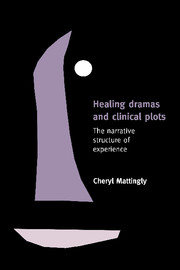Book contents
- Frontmatter
- Contents
- Preface
- Acknowledgments
- 1 Finding narrative in clinical practice
- 2 The mimetic question
- 3 The checkers game: clinical actions in quest of a narrative
- 4 Therapeutic plots
- 5 The self in narrative suspense: therapeutic plots and life stories
- 6 Some moments are more narrative than others
- 7 Therapeutic plots, healing rituals, and the creation of significant experience
- Notes
- References
- Index
7 - Therapeutic plots, healing rituals, and the creation of significant experience
Published online by Cambridge University Press: 05 June 2012
- Frontmatter
- Contents
- Preface
- Acknowledgments
- 1 Finding narrative in clinical practice
- 2 The mimetic question
- 3 The checkers game: clinical actions in quest of a narrative
- 4 Therapeutic plots
- 5 The self in narrative suspense: therapeutic plots and life stories
- 6 Some moments are more narrative than others
- 7 Therapeutic plots, healing rituals, and the creation of significant experience
- Notes
- References
- Index
Summary
It is difficult to speak of life as a storymaking venture without falling into a number of traps, portraying a world which is: (a) overly individualistic where single agents control their own destiny; (b) overly instrumental where attempting to create a story is equivalent to pursuing means to achieve ends and narrative endings appear as nothing more than instrumental goals; (c) overly coherent and free where we each, through our choosing, live out a single, unified life story; (d) overly selfconscious, where human agents act only on the basis of deliberate choices.
In developing a narrative theory of social action and experience, I have tried to avoid the illusions that we operate as individuals outside social contexts, that we can simply will into existence what we choose, that our motivations are largely self-conscious, or that our lives have the coherence and order of the well-told tale. Rather, I have turned to narrative as a framework to highlight quite other features of human experience, particularly the deeply disturbing relationship between trying to live lives which make sense to us (even narrative sense, I would say) and finding our attempts interrupted by the world around us or, equally disconcerting, finding we need to revise our conceptions of what a good life should or could, realistically, be. If narrative offers a homology to lived experience, the dominant formal feature which connects the two is not narrative coherence but narrative drama.
- Type
- Chapter
- Information
- Healing Dramas and Clinical PlotsThe Narrative Structure of Experience, pp. 154 - 169Publisher: Cambridge University PressPrint publication year: 1998



